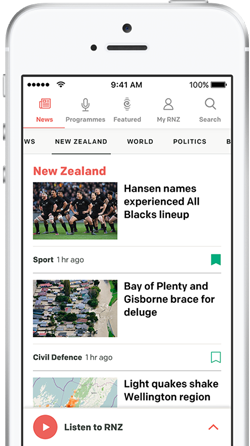
A boat at Evans Bay, Wellington, 31 July 2025. Photo: RNZ / Mark Papalii
Emergency officials have extended the tsunami threat for New Zealand and have urged people to stay away from shorelines until at least 3pm.
An 8.8 magnitude earthquake struck off Russia's remote east coast on Wednesday, triggering tsunami waves on multiple country's shores - including New Zealand, several Pacific nations, the US and Canadian coasts, and parts of South America.
The quake is tied for the sixth-strongest ever recorded, and the strongest since 2011, when a 9.0 magnitude earthquake hit northeast Japan, triggering a devastating tsunami.

Oriental Bay, Wellington, 31 July 2025. Photo: RNZ / Mark Papalii
Tsunami currents reached parts of the country overnight and National Emergency Management Agency (NEMA) warned the first surges were unlikely to be the largest.
NEMA said the threat for New Zealand's coast was likely to remain in place until at least 3pm.
Read more:
- Follow RNZ's live updates
- Just how strong can an earthquake get
- What the quake off Russia has in common with the strongest ever
- What's going on with tsunami phone alerts?
Director of civil defence emergency management John Price told Morning Report there had been reports of tsunami activity in North Cape, Tauranga, Kaikōura, Castle Point, and Christchurch.
He said surges could injure and drown people, and there is a danger to swimmers, surfers, people fishing, and anyone close to shore.
"This is still an active threat. It is still a threat to human life."

People on the beach at Lyall Bay, Wellington, 31 July 2025. Photo: RNZ / Mark Papalii
Despite the warnings, people were walking dogs, running and swimming at Takapuna Beach.
For Irina Kalatcheva, it was a matter of distance. "If it was maybe close to New Zealand, yes of course we will not go to walk, but it's so far away," she said.

Despite warnings of tsunami activity, people were out on Takapuna Beach on Thursday morning. Photo: RNZ / Liu Chen
NEMA said the threat must be regarded as real until it advised otherwise.
Price told Morning Report there had been a glitch with the alert system which resulted in some people receiving multiple texts. There have been two official alerts and NEMA would be trying to work out why some people had received more than that.
Civil Defence Northland said the forecast tsunami activity in its region that had been expected at about 12am-1am, would coincide with high tide.
Further south, Bluff was not expected to see its earliest tsunami waves until at least 4.46 am.
Overnight, various online webcams, dotted along the country's coasts and monitored by RNZ did not appear to reveal any damage.
Boaties were advised not to remain on their vessels. Auckland Emergency Management opened four Civil Defence Centres for people lived aboard and who did not have friends or family to stay with.
General manager Adam Maggs told Morning Report no significant issues were raised or noted around Auckland overnight. Two boaties spent the night at its Waikeke Island civil defence centre.
Cook Strait ferries have been diverted from using the Tory Channel to the Marlborough Sound's northern entrance due to tsunami activity advisories.
Three sailings were affected overnight adding 40 minutes to the journey. The Marlborough Harbourmaster briefly lifted the order on Thursday morning, before reinstating it. An Interislander spokesperson said it would be reassessed after midday.
In Wellington, the East by West ferry which runs across the harbour between the CBD and Eastbourne cancelled services until at least 10am on Thursday.
Further afield, while many countries began to lift their tsunami warnings into the early hours of Thursday, others issued new ones.
The Ministry of Foreign Affairs said New Zealanders in affected areas should follow the advice of local authorities at all times, including any evacuation orders, and let family and friends in New Zealand know that they were safe.
Sign up for Ngā Pitopito Kōrero, a daily newsletter curated by our editors and delivered straight to your inbox every weekday.





